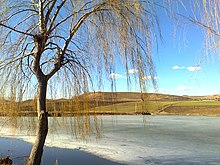Șăulia
|
Șăulia Mezősályi |
||||
|
||||
| Basic data | ||||
|---|---|---|---|---|
| State : |
|
|||
| Historical region : | Transylvania | |||
| Circle : | Mureș | |||
| Coordinates : | 46 ° 39 ' N , 24 ° 13' E | |||
| Time zone : | EET ( UTC +2) | |||
| Height : | 353 m | |||
| Area : | 26.25 km² | |||
| Residents : | 2,018 (October 20, 2011) | |||
| Population density : | 77 inhabitants per km² | |||
| Postal code : | 547590 | |||
| Telephone code : | (+40) 02 65 | |||
| License plate : | MS | |||
| Structure and administration (as of 2016) | ||||
| Community type : | local community | |||
| Structure : | Șăulia, Leorința-Șăulia , Măcicăşeşti , Pădurea | |||
| Mayor : | Dorel Grigore Vancea ( PSD ) | |||
| Postal address : | Str. Principală nr. 413 loc. Șăulia, jud. Mureș, RO-547590 |
|||
| Website : | ||||
Șăulia [ ˈʃəulia ] (outdated Șăulia de Câmpie ; Hungarian Mezősályi or Sályi ) is a municipality in the Mureş County , in the Transylvania region in Romania .
Geographical location
The municipality of Șăulia is located in the Transylvanian Heath (Câmpia Transilvaniei) - part of the Transylvanian Basin - in the west of the Mureș district, south of the Șesu stream and its dams. At the confluence of the district road (Drum județean) DJ 152B and DJ 151A, Șăulia is located 17 kilometers south of the small town of Sărmaşu and about 40 kilometers northwest of the district capital of Târgu Mureş (Neumarkt am Mieresch) .
history
The place Șăulia was first mentioned in 1377 and was a Romanian serf village in the Middle Ages . The incorporated village of Leorința-Șăulia (Hungarian Lőrincidűlő ) was first mentioned in 1913, Măcicăşeşti (Hungarian Macskás ) and Pădurea (Hungarian Erdőtanya ) only in 1956.
In the Kingdom of Hungary , the places of today's municipality belonged to the Marosludas chair district in the Torda-Aranyos County and then to the historical Mureș County and, from 1950, today's Mureș County.
Of the approximately 850 households in the municipality, only about 170 are connected to the public drinking water network and about ten households are connected to the sewage network. Furthermore, the waste management is in need of improvement, household and industrial waste that has not been deposited is also noted in the area of the municipality. In addition to agriculture and animal husbandry, natural gas is also extracted in the municipality. The natural gas here has a composition of 99% methane and 0.99% ethane .
population
The population of the municipality of Șăulia developed as follows:
| census | Ethnic composition | ||||
|---|---|---|---|---|---|
| year | population | Romanians | Hungary | German | other |
| 1850 | 1,122 | 921 | 49 | 3 | 149 |
| 1920 | 1,890 | 1,726 | 130 | 4th | 30th |
| 1956 | 2,888 | 2,753 | 22nd | - | 113 |
| 1992 | 2.003 | 1,855 | 25th | - | 123 |
| 2002 | 2.117 | 1,849 | 21st | - | 247 |
| 2011 | 2,018 | 1,615 | 28 | - | 375 |
Since 1850, the highest number of inhabitants and that of the Romanians in 1956 have been determined in the area of today's municipality. The highest number of Roma (329) was registered in 2011, that of Magyars (164) in 1910 and that of Romanian Germans (16) in 1890.
In 2011, 1,603 inhabitants were registered in the community center and in the incorporated villages of Leorința-Șăulia 155, Măcicăşeşti 153 and in Pădurea 107 inhabitants. 79.82% of them were Orthodox , 5.45% were Roman Catholics , 5.25% were Jehovah's Witnesses , 3.72% Pentecostals , and 2.92% of the population gave no information about their religious beliefs.
Attractions
- Except for the approximately 80 hectare reservoirs, which are used for fishing and also as a recreational area, there are no noteworthy sights in the municipality of Șăulia.
Web links
Individual evidence
- ↑ 2011 census in Romania ( MS Excel ; 1.3 MB)
- ↑ Heinz Heltmann, Gustav Servatius (Ed.): Travel Guide Siebenbürgen . Kraft, Würzburg 1993, ISBN 3-8083-2019-2 , p. 517 .
- ↑ a b c Town Hall of ăulia Municipality: Development Strategy of Șăulia Municipality 2014–2020. (PDF; 2.8 MB) Retrieved on May 12, 2019 (Romanian).
- ↑ Censuses 1850–2002, last updated November 2, 2008 (PDF; 1 MB; Hungarian).



